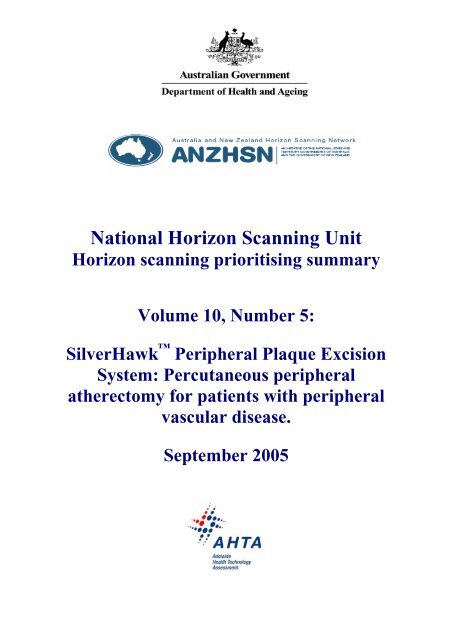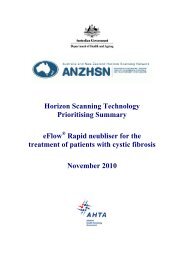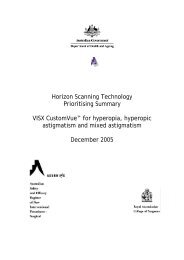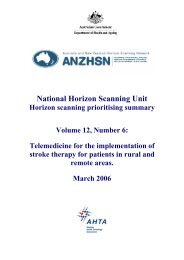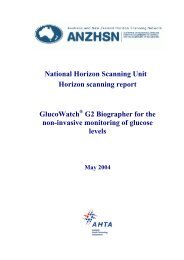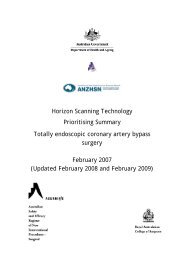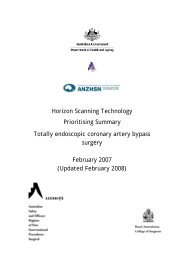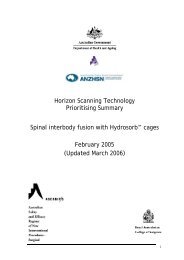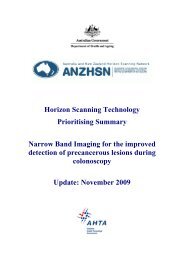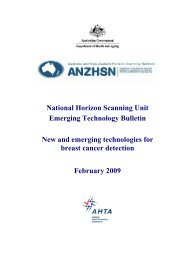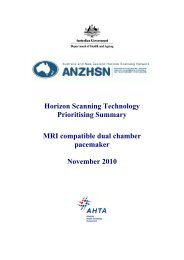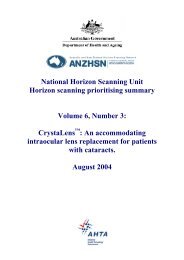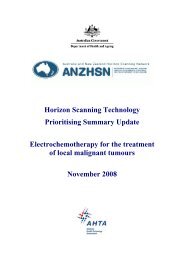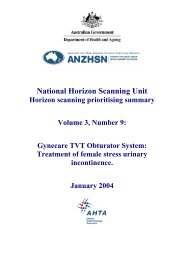SilverHawk⢠Peripheral Plaque Excision System - the Australia and ...
SilverHawk⢠Peripheral Plaque Excision System - the Australia and ...
SilverHawk⢠Peripheral Plaque Excision System - the Australia and ...
- No tags were found...
Create successful ePaper yourself
Turn your PDF publications into a flip-book with our unique Google optimized e-Paper software.
National Horizon Scanning UnitHorizon scanning prioritising summaryVolume 10, Number 5:SilverHawk <strong>Peripheral</strong> <strong>Plaque</strong> <strong>Excision</strong><strong>System</strong>: Percutaneous peripherala<strong>the</strong>rectomy for patients with peripheralvascular disease.September 2005
© Commonwealth of <strong>Australia</strong> 2005This work is copyright. You may download, display, print <strong>and</strong> reproduce this material inunaltered form only (retaining this notice) for your personal, non-commercial use or usewithin your organisation. Apart from any use as permitted under <strong>the</strong> Copyright Act 1968, allo<strong>the</strong>r rights are reserved. Requests <strong>and</strong> inquiries concerning reproduction <strong>and</strong> rights should beaddressed to Commonwealth Copyright Administration, Attorney General’s Department,Robert Garran Offices, National Circuit, Canberra ACT 2600 or posted athttp://www.ag.gov.au/ccaElectronic copies can be obtained from http://www.horizonscanning.gov.auEnquiries about <strong>the</strong> content of this summary should be directed to:HealthPACT SecretariatDepartment of Health <strong>and</strong> AgeingMDP 106GPO Box 9848Canberra ACT 2606AUSTRALIADISCLAIMER: This summary is based on information available at <strong>the</strong> time of research <strong>and</strong>cannot be expected to cover any developments arising from subsequent improvements tohealth technologies. This summary is based on a limited literature search <strong>and</strong> is not adefinitive statement on <strong>the</strong> safety, effectiveness or cost-effectiveness of <strong>the</strong> health technologycovered.The Commonwealth does not guarantee <strong>the</strong> accuracy, currency or completeness of <strong>the</strong>information in this summary. This summary is not intended to be used as medical advice <strong>and</strong>it is not intended to be used to diagnose, treat, cure or prevent any disease, nor should it beused for <strong>the</strong>rapeutic purposes or as a substitute for a health professional's advice. TheCommonwealth does not accept any liability for any injury, loss or damage incurred by use ofor reliance on <strong>the</strong> information.The production of this Horizon scanning prioritising summary was overseen by <strong>the</strong> HealthPolicy Advisory Committee on Technology (HealthPACT), a sub-committee of <strong>the</strong> MedicalServices Advisory Committee (MSAC). HealthPACT comprises representatives from healthdepartments in all states <strong>and</strong> territories, <strong>the</strong> <strong>Australia</strong> <strong>and</strong> New Zeal<strong>and</strong> governments; MSAC<strong>and</strong> ASERNIP-S. The <strong>Australia</strong>n Health Ministers’ Advisory Council (AHMAC) supportsHealthPACT through funding.This Horizon scanning prioritising summary was prepared by Adriana Parrella, Janet Hiller<strong>and</strong> Linda Mundy from <strong>the</strong> National Horizon Scanning Unit, Adelaide Health TechnologyAssessment, Department of Public Health, Mail Drop 511, University of Adelaide, South<strong>Australia</strong>, 5005.
REGISTER ID: 000174PRIORITISING SUMMARYNAME OF TECHNOLOGY:SILVERHAWK PERIPHERAL PLAQUE EXCISIONSYSTEMPURPOSE AND TARGET GROUP:PERCUTANEOUS PERIPHERAL ATHERECTOMY FORPATIENTS WITH PERIPHERAL VASCULAR DISEASESTAGE OF DEVELOPMENT (IN AUSTRALIA):⌧ Yet to emerge Established Experimental Established but changed indicationor modification of technique Investigational Should be taken out of useNearly establishedAUSTRALIAN THERAPEUTIC GOODS ADMINISTRATION APPROVAL Yes ARTG number⌧NoThe SilverHawk <strong>System</strong> is not currently available in <strong>Australia</strong> <strong>and</strong> is not listed on <strong>the</strong> <strong>Australia</strong>nRegister of Therapeutic Goods. The device received FDA approval in 2003 with <strong>the</strong> originalmodel of <strong>the</strong> device <strong>and</strong> fur<strong>the</strong>r approval in February 2005 for <strong>the</strong> current device.INTERNATIONAL UTILISATION:COUNTRYUnited StatesGermanyItalySwitzerl<strong>and</strong>Trials Underway orCompletedLEVEL OF USELimited UseWidely DiffusedIMPACT SUMMARY:FoxHollow Technologies has developed <strong>the</strong> SilverHawk <strong>Peripheral</strong> <strong>Plaque</strong> <strong>Excision</strong> <strong>System</strong>with <strong>the</strong> aim of treating a<strong>the</strong>rosclerotic lesions in patients with peripheral vascular disease.BACKGROUND<strong>Peripheral</strong> vascular disease refers to <strong>the</strong> narrowing of <strong>the</strong> lumen of arteries in <strong>the</strong> legs, causing areduction in circulation to <strong>the</strong> legs <strong>and</strong> feet. The most common cause of peripheral vasculardisease is a<strong>the</strong>rosclerosis. A<strong>the</strong>rosclerosis is characterised by <strong>the</strong> accumulation of cells, matrixfibres, lipids <strong>and</strong> tissue debris in <strong>the</strong> arterial lumen. The build-up of a<strong>the</strong>rosclerotic plaque maylead to ulceration, embolisation <strong>and</strong> thrombosis (Ru<strong>the</strong>rford 2000).1
There are several surgical <strong>and</strong> non-surgical options for <strong>the</strong> removal of a<strong>the</strong>rosclerotic plaque fromarterial walls. The Silverhawk is designed to perform a<strong>the</strong>rectomy, a procedure that cuts offplaque from arterial walls. There are several established techniques for performing a<strong>the</strong>rectomywithin blood vessels. Some of <strong>the</strong>se techniques are used in both peripheral <strong>and</strong> coronaryvasculature. Rotational a<strong>the</strong>rectomy to remove plaque involves pulverising plaque with arotablator <strong>and</strong> flushing <strong>the</strong> microparticles out in <strong>the</strong> bloodstream. Directional a<strong>the</strong>rectomyinvolves inflating a balloon to push <strong>the</strong> blade toward <strong>the</strong> plaque, cutting <strong>the</strong> plaque with <strong>the</strong>rotablator, storing it within <strong>the</strong> ca<strong>the</strong>ter device. The plaque is removed when <strong>the</strong> ca<strong>the</strong>ter iswithdrawn. A percutaneous transluminal extraction uses a ca<strong>the</strong>ter with a rotablator <strong>and</strong> a hollowtube that allows for <strong>the</strong> plaque to be sucked through it <strong>and</strong> expelled from <strong>the</strong> body. 1An a<strong>the</strong>rectomy may be performed ei<strong>the</strong>r instead of, or in addition to, <strong>the</strong> more traditional balloonangioplasty when plaque has become exceptionally hard (due to calcification) or presents o<strong>the</strong>rchallenges. A rigid artery may prevent a stent from exp<strong>and</strong>ing properly to hold <strong>the</strong> vessel open,which may lead to re-narrowing (restenosis) or blockage altoge<strong>the</strong>r.The SilverHawk <strong>Peripheral</strong> <strong>Plaque</strong> <strong>Excision</strong> <strong>System</strong> is intended for <strong>the</strong> a<strong>the</strong>rectomy of <strong>the</strong>peripheral vasculature including femoral-popliteal <strong>and</strong> tibial-peroneal vessels <strong>and</strong> is not approvedfor use in <strong>the</strong> coronary or carotid vasculature (United States Food <strong>and</strong> Drug Administration,2005).The SilverHawk <strong>System</strong> is approved in Europe for <strong>the</strong> treatment of both coronary <strong>and</strong> peripheralarterial disease. In <strong>the</strong> coronary arteries, plaque excision with <strong>the</strong> SilverHawk has been used totreat bifurcation lesions, ostial lesions, long lesions <strong>and</strong> in-stent restenosis. In <strong>the</strong> peripheralarteries, it is most commonly used to treat <strong>the</strong> femoral-popliteal <strong>and</strong> tibial-peroneal arteries in <strong>the</strong>legs (FoxHollow Technologies 2005).The SilverHawk <strong>Peripheral</strong> <strong>Plaque</strong> <strong>Excision</strong> <strong>System</strong> consists of two major components usedtoge<strong>the</strong>r during <strong>the</strong> a<strong>the</strong>rectomy procedure, <strong>the</strong> SilverHawk <strong>Peripheral</strong> Ca<strong>the</strong>ter <strong>and</strong> SilverHawkCutter Driver (United States Food <strong>and</strong> Drug Administration, 2005). The plaque excisionprocedure is performed by inserting <strong>the</strong> SilverHawk <strong>Peripheral</strong> Ca<strong>the</strong>ter through a puncture in<strong>the</strong> leg or arm <strong>and</strong> advancing to <strong>the</strong> blocked or narrowed area of <strong>the</strong> vein/artery. Once <strong>the</strong> ca<strong>the</strong>teris at <strong>the</strong> site of <strong>the</strong> blockage a small rotating blade is activated, shaving plaque off <strong>the</strong> arterywalls. The plaque is collected in <strong>the</strong> tip of <strong>the</strong> ca<strong>the</strong>ter <strong>and</strong> <strong>the</strong>n removed with <strong>the</strong> ca<strong>the</strong>ter(FoxHollow Technologies 2005). This technique is a modified directional a<strong>the</strong>rectomy procedure,as it does not employ a balloon to move <strong>the</strong> blade towards <strong>the</strong> plaque.CLINICAL NEED AND BURDEN OF DISEASE<strong>Peripheral</strong> Vascular Disease (PVD) is associated with a significant increase in cardiovascularmorbidity <strong>and</strong> mortality. Patients with PVD are approximately 5 times more likely to have anacute myocardial infarction (AMI) <strong>and</strong> two to three times more likely to have a stroke (Treat-Jacobsen <strong>and</strong> Walsh 2003) than patients without PVD. The mortality in patients with claudicationis 30% at 5 years, 50% at 10 years, <strong>and</strong> 70% at 15 years, <strong>and</strong> mortality increases with diseaseseverity (Treat-Jacobsen <strong>and</strong> Walsh 2003; Leng et al 1996). The major preventable risk factors1 Percutaneous transluminal coronary rotational a<strong>the</strong>rectomy (PTCRA) was approved by MSAC in 2002 for<strong>the</strong> revascularisation of complex <strong>and</strong> heavily calcified coronary artery lesions as an adjunct to percutaneoustransluminal coronary angioplasty (PTCA) or when previous PTCA attempts have not been successful; <strong>and</strong>for revascularisation of complex <strong>and</strong> heavily calcified coronary artery stenoses where coronary arterybypass graft (CABG) surgery is contra-indicated (MSAC 2005).2
for PVD include diabetes, tobacco smoking, high blood cholesterol, high blood pressure <strong>and</strong>overweight <strong>and</strong> obesity (Treat-Jacobsen <strong>and</strong> Walsh 2003).No national data are available on <strong>the</strong> prevalence of PVD in <strong>Australia</strong> (AIHW 2001). In 2001–02,<strong>the</strong>re were 24,288 hospitalisations where PVD was <strong>the</strong> principal diagnosis, representing 0.4% ofall hospitalisations in <strong>Australia</strong> (AIHW 2004). Of <strong>the</strong> hospitalisations for heart, stroke <strong>and</strong>vascular diseases, PVD accounted for 5.5%. A<strong>the</strong>rosclerosis of <strong>the</strong> peripheral arteries accountedfor over half (13,564) of <strong>the</strong>se hospitalisations (AIHW 2004).Among those hospitalised for at least one night with PVD, <strong>the</strong> average length of stay was 11.5days (AIHW 2004). On average, those hospitalised for PVD tended to stay almost twice as longas those hospitalised for coronary heart disease.In 2002 <strong>the</strong>re were 1,347 <strong>and</strong> 1,234 deaths in males <strong>and</strong> females respectively from PVD (AIHW2004).DIFFUSIONIt is likely that <strong>the</strong> device would diffuse into clinical practice ei<strong>the</strong>r as a st<strong>and</strong>-alone procedure oras an adjunctive <strong>the</strong>rapy if it demonstrates effectiveness in addressing <strong>the</strong> reported limitations ofstenting <strong>and</strong> balloon angioplasty.COMPARATORSThe treatment options for removal of a<strong>the</strong>rosclerotic plaque depend on <strong>the</strong> severity <strong>and</strong> type ofocclusions. In mild forms, lifestyle modifications (smoking cessation, diet, physical activity) <strong>and</strong>pharmacological <strong>the</strong>rapy (anti-platelet agents, manage hypertension, cholesterol <strong>and</strong> diabetes) areemployed (Burns et al 2003).More invasive alternatives involve open surgical techniques to bypass or replace <strong>the</strong> diseasedvessel <strong>and</strong> o<strong>the</strong>r percutaneous endovascular techniques such as stenting <strong>and</strong> balloon angioplasty.The endovascular techniques increase arterial luminal diameter by stretching <strong>the</strong> vessel whereasa<strong>the</strong>rectomy removes a<strong>the</strong>rosclerotic plaque.EFFECTIVENESS AND SAFETY ISSUESAt <strong>the</strong> time of writing <strong>the</strong>re were limited published studies of <strong>the</strong> SilverHawk reporting clinicaleffectiveness <strong>and</strong> safety outcomes in a total of 63 patients (Zeller et al 2004a; Pershad <strong>and</strong>Stevenson 2005; Ikeno et al 2004). All identified studies provided low evidence (level IVintervention) with maximum follow-up periods of six months.In a study of 52 patients with a total of 71 lesions <strong>the</strong> SilverHawk was used to extract plaquefrom <strong>the</strong> common femoral (n=2), superficial femoral (n=52) <strong>and</strong> <strong>the</strong> popliteal (n=17) arteries,(Zeller et al 2004). In eight patients (15%) more than one lesion was treated. The average lesionlength was 48 ± 64mm (range 10-300). All procedures were performed without complications.One lesion required predilation (<strong>the</strong> authors do not report how this was carried out) prior toa<strong>the</strong>rectomy. After <strong>the</strong> Silverhawk procedure, residual stenosis was ≤30% in 54 (76%) lesions<strong>and</strong> ≤50% in 68 (98%) lesions. Following a<strong>the</strong>rectomy with <strong>the</strong> SilverHawk , <strong>the</strong> study reports41 (58%) lesions were balloon dilated to smooth <strong>the</strong> contour of <strong>the</strong> lesion <strong>and</strong> that a stent wasimplanted in 4 (6%) lesions.3
A<strong>the</strong>rectomy results post-intervention are included in Table 1 below. Duration of <strong>the</strong> procedure,number of device insertions <strong>and</strong> number of lesions passes was significantly higher in <strong>the</strong> in-stentrestenosisgroup because of <strong>the</strong> doubled lesion length in this group.The average diameter stenosis (DS) after a<strong>the</strong>rectomy was reduced from 84 ± 10% (range 70-100%) to 27 ± 23% (range 0-100%) <strong>and</strong> <strong>the</strong> minimal lumen diameter was increased from0.88±0.70 to 3.69 ± 0.90mm (Zeller et al, 2004).The study reports one patient died at two months post-a<strong>the</strong>rectomy from a myocardial infarction(Zeller et al, 2004). At six months, restenosis rates were not significantly lower in <strong>the</strong> primarylesion (27%) compared to <strong>the</strong> o<strong>the</strong>r groups (41% for restenoses <strong>and</strong> 36% for in-stent restenoses).Reintervention rates were lowest in <strong>the</strong> primary lesions. The average ankle-brachial index (ABI)in <strong>the</strong> entire study group increased from 0.62 ± 0.24 to 0.87 ± 0.27 after treatment, 0.84 ± 0.24after three months <strong>and</strong> 0.72±0.21 after six months (Table 2).Table 1Acute A<strong>the</strong>rectomy ResultsPrimary Lesion(n=30)Restenotic Lesion(n=27)In-StentRestentosis(n=14)P valueLesion passes 7.1±2.9 6.8±3.6 99.9±3.2 0.02Device insertions 2.0±1.2 2.0±1.1 3.5±1.7 0.01Duration of a<strong>the</strong>rectomy, min 11±8 11±4 20±14 0.04MLD post-a<strong>the</strong>rectomy, mm 3.6±1.0 3.8±0.7 3.3±1.2 NSDS post-a<strong>the</strong>rectomy, % 29±18 22±15 31±23 NSMLD final, mm 4.4±0.7 4.4±0.7 4.2±0.5 NSDS final, % 15±9 8±9 14±8 0.01Balloon angioplasty 17 (57%) 16 (59%) 8 (57%) NSStenting 1 (3%) 2 (8%) 1 (7%) NSABI before discharge 0.84±0.019 0.77±0.15 0.85±0.12 NSMLD: minimal lumen diameter, ABI: ankle brachial index, DS: diameter stenosisSource: Zeller et al, 20044
Table 2A<strong>the</strong>rectomy Results at 3 <strong>and</strong> 6 monthsPrimary Lesion(n=30)Restenotic Lesion(n=27)In-StentRestentosis(n=14)P valueThree monthsRestenosis %2 (7%)8 (30%)3 (21%)NSReintervention %ABI1 (3%)0.84 ±0.198 (30%)0.77±0.153 (21%)0.86±0.120.020.049Six monthsRestenosis %8 (27%)11 (41%)5 (36%)NSReintervention %6 (20%)10 (37%)4 (29%)NSABIPrimary patency %Assisted primary patency %Secondary patency %Source: Zeller et al, 20040.72±0.2801001000.64±0.166396960.72±0.27717993NSNSNSNSTen patients underwent a<strong>the</strong>rectomy with <strong>the</strong> Silverhawk on a total of 12 lesions located in <strong>the</strong>left anterior descending artery (n=four), right coronary artery (n=five), left circumflex coronaryartery (n=one), a diagonal branch <strong>and</strong> in one saphenous vein graft (Ikeno et al 2004). There werefour bifurcations, six in-stent restenoses <strong>and</strong> one de novo lesion. The SilverHawk ca<strong>the</strong>ter wassuccessfully inserted in 11 of 12 lesions (92%) without complications. The ca<strong>the</strong>ter in <strong>the</strong>diagonal branch failed to cross. In <strong>the</strong> 11 treated lesions, an average of 9.9 ± 5.0 cutting passeswas made in 3.1±0.8 insertions. The total excised tissue per lesion was 15.2 ± 7.8 mg. Eight of<strong>the</strong> lesions (73%) had adjunctive <strong>the</strong>rapy with ei<strong>the</strong>r balloon angioplasty or stent placement.The manufacturer’s website lists seven abstracts presented at <strong>the</strong> Transca<strong>the</strong>ter CardiovascularTherapeutics Symposium 2004 of single-centre data in an estimated 635 patients (Fox Hollow2005) 2 . An abstract presented at <strong>the</strong> Society of Vascular Surgery Annual Vascular Meeting 2005includes data (level 1V intervention evidence) collected from a registry of centres using <strong>the</strong>Silverhawk , <strong>and</strong> reports on clinical outcomes at six months in 505 patients (Ramaiah et al 2005).Endpoints include immediate procedural <strong>and</strong> angiographic outcomes <strong>and</strong> target lesionrevascularization (TLR) at 6 <strong>and</strong> 12 months. <strong>Plaque</strong> excision was performed in 505 patients, 617limbs <strong>and</strong> 1047 lesions. A total of 88.3% of <strong>the</strong> lesions were de novo <strong>and</strong> 11.7% were restenotic.Chronic total occlusions (CTO) accounted for 27.8% of lesions. St<strong>and</strong> alone plaque excision wasperformed in 74.3% of patients, with an adjunctive stent placement rate of 5.3%. Angiographicoutcomes in st<strong>and</strong> alone SilverHawk cases showed a greater than 75% reduction in <strong>the</strong> averagediameter stenosis (pre-SilverHawk 85.7% vs. post-SilverHawk 10.1%).The presentation included data available for 317 lesions from patients who had reached <strong>the</strong> 6month follow-up point. Revascularisation occurred in 35/317 (11%) lesions. The TLR rate inpatients with a single lesion treated was 3/65 (4.6%). The TLR rate was 7/85 (8.2%) of CTOlesions (Ramaiah et al 2005).2 One abstract (Allie et al 2004) states number of lesions treated but not <strong>the</strong> number of patients.5


